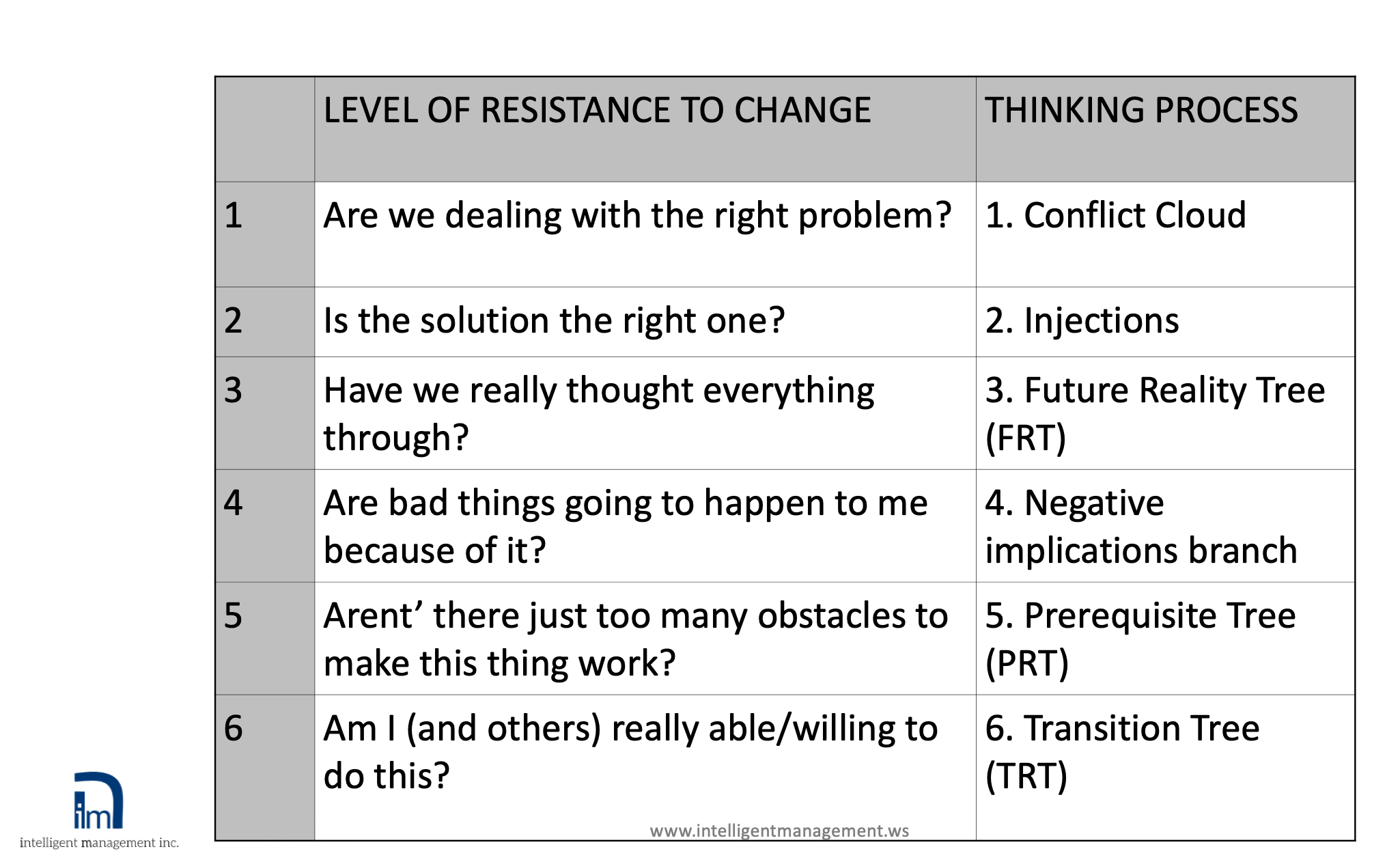
Every solution is a change. If entrepreneurs and leaders want new solutions to be implemented successfully, then all those involved have to be able to adapt their way of behaving to the requirements of that solution.
This means we have to develop and communicate this solution in a way that everyone is involved in its construction. They need to be part of building the change and in that way they can own it.
Thanks to the depth of thinking and research carried out in a semi-empirical way, Dr. Eliyahu Goldratt was able to identify six levels of resistance to change. These levels depend on the extent of awareness and participation of the people involved. When we are able to identify which level of resistance corresponds with people’s reactions, we are well on the way to resolving the problem. Moreover, for every level of resistance there is a Thinking Process that will address and resolve that resistance in a collaborative way. We can say with confidence after introducing these Thinking Processes to companies for over twenty years that they are an extraordinary support for introducing and managing change in a way that can work.
Leading and managing change: it’s a process that includes you
However, there is a very important lesson here for entrepreneurs and leaders. It’s not enough to ask people to change. The level of conscious choice that comes with a process of change must come first and foremost from the leader. If a leader is not able to work first on themself and see what they need to change, they will have much less success in asking others to do the same. Leading and managing change starts with being willing and able to change ourselves wherever that is necessary. It’s an ongoing process because we have infinite possibilities to fulfil our potential.
The process of change goes through various phases, or levels of resistance that we can work through. Let’s look at the six levels of resistance to change, as identified by Goldratt in the Theory of Constraints.
Level 1: Disagreement about the problem
This is the deepest level of resistance. At this stage there is no common agreement about what the problem is that is to be addressed through some form of change. To tackle this level, we need to identify the cause of the majority of negative Undesirable Effects (UDEs) that are being experienced. This can be done very effectively and quite fast through the core conflict cloud, starting from listing all the UDEs, or symptoms of the problem that needs to be addressed. No matter how complex the problem, this can be done very effectively and quite fast through the method of the Core Conflict Cloud
Level 2: Is the solution the right one?
Once there is agreement about what needs to be changed, there must be agreement about how the change will be implemented. The direction of the solution is found by identifying solutions to the core conflict (these solutions are called “injections” in Theory of Constraints) . We do this by invalidating the assumptions (mental models) that keep people stuck in the core conflict. It allows a shift towards a stage of agreement where it is no longer “you against me because of the problem” but “you and me against the problem”.
Level 3: Have we really thought everything through?
This level reflects a disconnect between the understanding of change required and the logic that will bring the results. A fully fleshed out solution needs to be mapped out. For this reason we build a Future Reality Tree. This process gathers together all the “injections” with a supporting logic to prove that the proposed changes will bring results. It also leads to identifying further injections that complete the solution. The result is a clear map that becomes a living document shared among those involved in the change process.
Level 4: Are bad things going to happen to me because of change?
People will be sensitive to possible negative implications they perceive for themselves through the implementation of the solution. It is important to identify negative implications early to:
- protect the proposed changes from unexpected difficulties;
- get buy-in from people who may tend to be nay-sayers;
- demonstrate leadership through an ability to listen to relevant objections and incorporate that feedback.
The Thinking Process for this is called Negative Branch Reservation.
Level 5: Aren’t there too many obstacles to make this work?
At this level, the solution is much closer to being accepted as a reality and people’s objections are at a very concrete level of obstacles in the way, often in the shape of a lack of resources.
The people who see the obstacles are often the very ones with the knowledge to tackle them. It is vital to be able to address and overcome these obstacles and the process for this is called an Intermediate Objective. All the necessary Intermediate Objectives can be mapped out on a Prerequisite Tree in a logical order of what needs to be done first before another IO can be achieved.
Level 6: Am I (and are others) really able/willing to do this?
After level 5 has been overcome, we are in a situation where all we need to do is take the actions to achieve the Intermediate Objectives. Even so, at this stage people may freeze. This may be simply because there is not enough clarity on tasks or because not all the objections have been raised. This is a critical phase in terms of leadership and can be greatly facilitated by giving and sharing clear instructions through the use of the Transition Tree.

The Thinking Processes promote and reinforce the kind of systemic intelligence needed to create and manage an organization as a whole system. They provide a complete and holistic approach in a continuum from high-level strategy through to detailed step-by-step implementation. They are both the means and the method to create, communicate and share any process of change. They reinforce and cultivate the true involvement of people and are therefore crucial for improving flow in communication which, in turn, enables better flow in every sense.
Step Six of The Decalogue
In this series on the Ten Steps of the Decalogue, in Step Three, ‘Make the system Stable’, we looked at reducing variation in a process and in Step Five we looked at managing the whole organization through a constraint. This all comes together in Step Six: Reduce variation of the constraint(s) and the main processes
In a relentless quest to improve the performance of our organization, it is clear that reducing variation is key. Less variation means more reliability, dependability and consistency. It means more Quality and better performance. This is precisely what we must pursue.
If we want our efforts to reduce variation to succeed, then people in the organization need to understand the change that they are being asked to make. This means we have to develop and communicate this solution in a way that everyone is involved in its construction. They need to be part of building the change. Using the Thinking Processes to overcome the six levels of resistance to change is fundamental to achieving success with this shift.
But, when push comes to shove, it’s complicated to continue to work on reducing variation. Why?
The culturally disappointing translation of Deming’s Philosophy into a myriad of “Kaizen-like” management techniques has transformed it from a vision of the world based on innovation and wealth creation into an efficiency game. If, on top of this, we continue to view our company in “functional” terms, then reducing variation simply means reducing costs. Of course, no function would ever easily surrender to that because it would imply “cutting the budget,” hence any serious attempt to reduce variation is nipped in the bud. A relentless effort toward continuous reduction in variation can only stem from a systemic vision of our company and the understanding that only this reduction will provide the insight needed for triggering real jumps in performance. The way to link a relentless, focused and companywide variation reduction crusade to financial performance is through the adoption of a suitable organizational structure. (We will look at this in Part 12 of this series.)
Try it for yourself
The Theory of Constraints identifies three main phases in managing change:
What to change
What to change to
How to make the change happen
In your organization, is it clear what actually needs to change? Is it clear what the outcome of that change should be? Do you have a reliable method to identify and implement the changes and deal with the various obstacles along the path?
See Part 12 of this series: End Silos and Dissatisfaction: Learn to Operate as a Network of Projects Organization
PREVIOUS POSTS IN THIS SERIES:
Radically Improving Organizational Performance – A Systemic Approach to Management Part 1
Leadership for Complex Times – A Systemic Approach to Management Part 5
Working with Variation to Support Good Decision Making – A Systemic Approach Part 7
Why Your Organization’s Constraints Are the Key to Success – A Systemic Approach Part 8
Improving Flow Company Wide – A Systemic Approach Part 9
Controlling the Whole Organization through the Constraint – A Systemic Approach Part 10






Leave a Reply